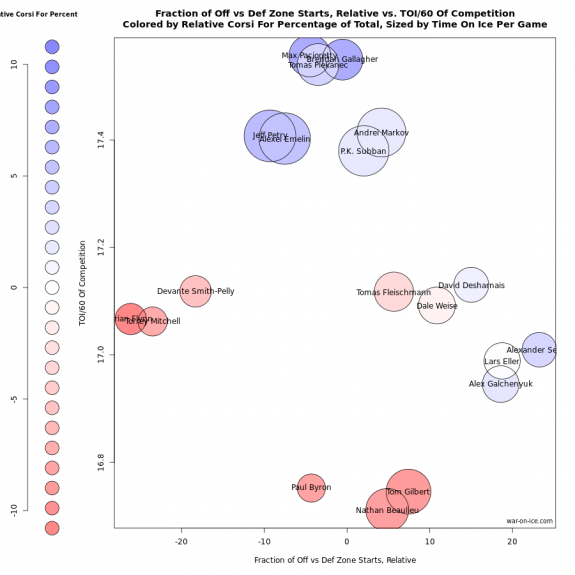Since making his debut with the Montreal Canadiens in the 2009-10 season, David Desharnais has been the victim of a lot of criticism — some of it justified and some of it overwhelmingly over-the-top.
You see, over the past few seasons, Desharnais was given the burdensome task of centering the first line alongside star left winger Max Pacioretty. During his time on the first line, the diminutive forward showed the hockey world what type of player he can be. His vision and creativity in the offensive zone became apparent early on in his career. Not to mention, Desharnais’ no-quit attitude and strong work ethic resonated well with his teammates. No one questioned Desharnais’ drive to win.
What they did question was his ability to be a top-line center, and rightfully so.
Although Desharnais possessed an excellent skill set, he lacked the defensive acumen required to be an effective first-line center. On many nights, Desharnais would get burned in the defensive zone, either getting outmuscled along the boards or losing his man and blowing coverage. It was obvious he didn’t belong in the role he was put in, and he was the brunt of the blame (when things went wrong) because of it.
Some of that blame was certainly justifiable, but head coach Michel Therrien didn’t help matters by hanging him out to dry on the first line for extended periods of time. The diminutive center was not equipped for the responsibility that comes with playing alongside Max Pacioretty, and that has never been more evident than now.
Through the first month of the 2015-16 season, Desharnais has not seen ice time with Max Pacioretty on the first line. In fact, he’s been centering the third line with Tomas Fleischmann and Dale Weise for the entire season, and it has changed things dramatically.
Role Change
Usually, a demotion is never a good thing, no matter how you look at it. In Desharnais’ case, though, that could not be further from the truth.
Since starting the season on the third line, Desharnais has seen a significant drop-off in his minutes. As a top-line center, Desharnais averaged between 16 and 18 minutes of ice time (last four seasons). Desharnais’ ATOI (average time on ice) has now dropped to just under 14 minutes per game 13 games into the season.
A drop-off in minutes can demotivate a player and sometimes leads to poorer results. That has not been the case with the 28-year-old Quebec native.

As you can see from the chart above, Desharnais is receiving relatively easy minutes, going up against below-average opponents in sheltered zone starts. This has led to an improvement in Desharnais’ overall even-strength play, posting respectable possession numbers while generating more scoring chances down the middle.
Ironically enough, Desharnais is now producing more scoring chances at even strength than he did while he was on the first line (a line built to produce scoring chances). He is also preventing high-danger chances at a much more efficient rate. Just last season, Desharnais was giving up over 11 HSCA (high-danger scoring chances against) per 60 minutes at even strength. That number has diminished to well under 10 HSCA per 60 minutes at ES — about a 12.75 percent drop.
These numbers prove Desharnais is not necessarily playing at a much higher level, but benefiting from a role he’s much more comfortable playing. However, results are what truly matter, and Desharnais has delivered that in spades.
Results
The Habs are playing excellent hockey right now, and they have the best record in the NHL to show for it. A big part of that has been the team’s secondary scoring, and with Desharnais now on the third line, he is leading the pack.
Desharnais’ improved play at even strength has shown up on the scoreboard. Not only is Desharnais on pace for a career year — on pace for 19 goals, 57 assists and 76 points — but he’s doing so in significantly less ice time, which makes his first month on the third line all the more impressive. Desharnais leads the team in points produced per 60 minutes at even strength with a 4.07 average, which is more than double his career-best.
Desharnais might have his best season ever by playing outside the top-6. #Habs
— Rob Elbaz (@RobElbaz) November 2, 2015
Now, there is a silver lining to all this, and that is that Desharnais’ line is scoring goals at a pace that is simply not sustainable over an 82-game season. Put it this way — Dale Weise is not going to notch multiple hat tricks this season. This line will undoubtedly go through a cold streak, and we will likely hear Desharnais’ name in a not-so-positive light more than once this season.
Having said that, even though the first month of the season is a small sample size, it’s encouraging to see Desharnais playing in a role he belongs in and reaping the benefits because of it.